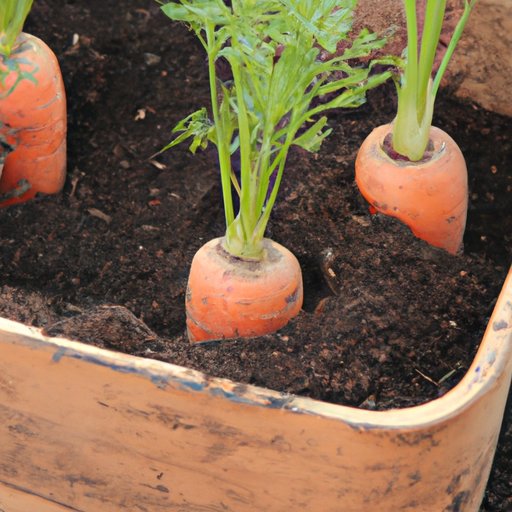
I. Introduction
Carrots are a popular and nutritious vegetable that can be eaten raw or cooked in a variety of ways. However, many people struggle with planting them in their garden or might not know how to begin. This article aims to provide a comprehensive guide for novice gardeners on how to plant carrots successfully.
II. Step-by-Step Guide
Selecting the right soil: Carrots require loose, well-draining soil with a pH of 6.0 to 6.8. Consider testing your soil and adjusting the pH level if necessary.
Preparing the soil: Remove any rocks, roots, or debris from the soil and loosen the soil to a depth of 12-15 inches using a garden fork or tiller.
Planting the seeds: Sow carrot seeds about ¼ inch deep and 1-2 inches apart. Cover the seeds with fine soil and water them immediately.
Watering and fertilizing the carrots: Keep the soil consistently moist but not waterlogged. Water deeply once a week during dry periods. Fertilize the soil with aged compost or a balanced fertilizer, but avoid using fresh manure.
Protecting the carrots from pests and diseases: Cover the carrots with a floating row cover to keep pests such as carrot fly and aphids at bay. Keep an eye out for common diseases such as leaf blight and remove any infected plants immediately to prevent spreading.
Harvesting the carrots when they’re ready: Carrots will be ready for harvest around 70-80 days after planting. Gently pull them out of the soil, being careful not to damage them.
III. Container Gardening
Benefits of growing carrots in containers: Container gardening is a great option for those with limited space or poor-quality soil.
Selection of the right container: Choose a container that is at least 12 inches deep and wide enough to hold several carrots. The container should have drainage holes to prevent waterlogging.
Soil requirements: Use a high-quality potting mix that is loose and well-draining.
Care and maintenance of the container-grown carrots: Water the container regularly to keep the soil moist. Fertilize the carrots every 2-3 weeks with a balanced fertilizer. Rotate the container occasionally to ensure that the plants receive even sunlight.
IV. Companion Planting
Benefits of companion planting with carrots: Planting certain crops alongside carrots can help improve their flavor and deter pests.
Suggested plants to plant alongside carrots: Some great companion plants for carrots include onions, garlic, peas, and lettuce.
How to plant and care for companion plants: Plant companion plants alongside carrots in the same bed or container. Be sure to space them appropriately for optimal growth. Provide them with the same care and maintenance as you would for carrots.
V. Troubleshooting
Common challenges encountered when planting carrots: Carrots are prone to diseases such as leaf blight, rust, and root-knot nematodes. They are also attractive to pests such as carrot fly, aphids, and cutworms.
Pests and diseases to watch out for: Keep an eye out for pests and diseases mentioned above.
Preventative measures to mitigate weather challenges: Cover the carrots with a floating row cover to protect them from harsh weather conditions and pests. Keeping your garden weed-free can help prevent diseases from spreading.
VI. Varieties of Carrots
Overview of different types of carrots: There are different types of carrots available, such as the baby, Nantes, Chantenay, and Imperator carrots.
Best carrots for different types of dishes: Baby carrots are good for appetizers or as a snack, while Chantenay carrots are best for roasting and Nantes carrots for salads.
How to store carrots after harvest: Store harvested carrots in a cool, dark, and humid place, such as a refrigerator.
VII. Carrot Recipes
Here are some easy-to-make carrot recipes you can try:
- Carrot cake
- Roasted Carrots and Parsnips
- Roasted garlic carrots
- Carrot and ginger soup
- Carrot and orange salad
VIII. Conclusion
Planting carrots is a simple and rewarding process that anyone can enjoy, even if they don’t have a lot of gardening experience. We hope this guide has provided you with the information and guidance you need to grow your own delicious carrots in your backyard or container garden.




